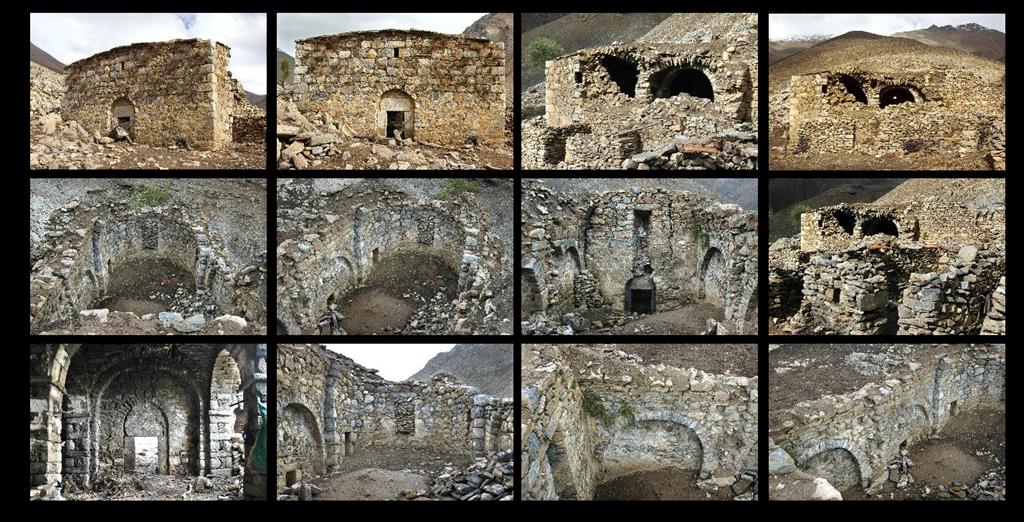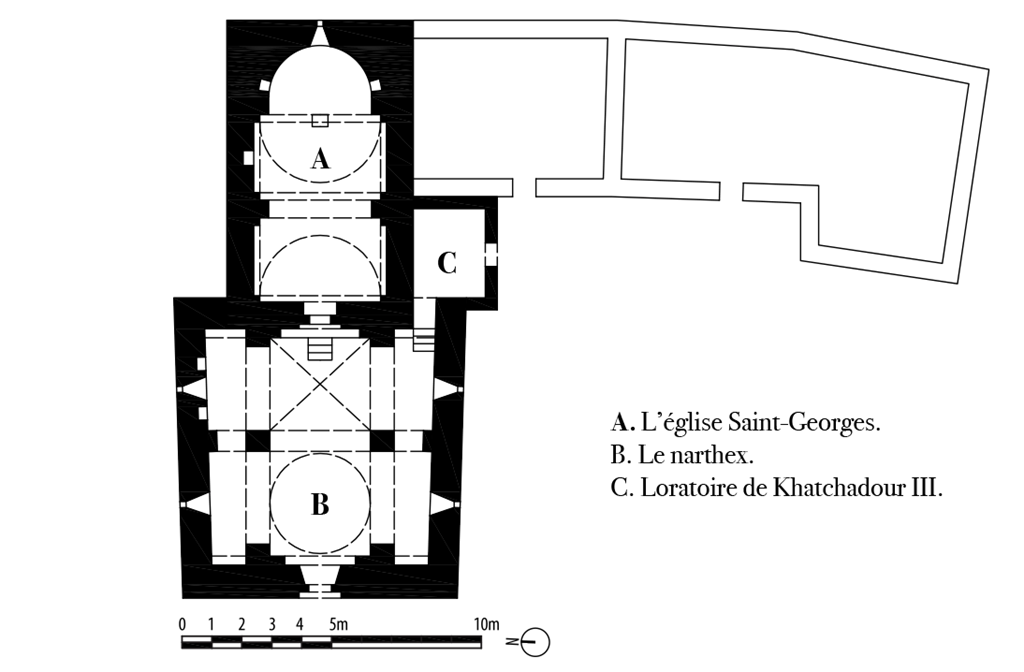The Saint George monastery or desert stands in the Armenian canton of Arantznag Mogs, in the western branch of the Ardos mountains [Artos Dağı]; it was built on the south slope of Mount Egherovn [Agerov Dağı], at an altitude of 2400 m, at 38° 12’ N and 42° 46’ E, at the foot of the P‘ut‘gu Vank‘ pass [Ağzı Gedik] used by the old mountain road that runs from Osdan [Gevaş] near the southeast corner of Lake Van to Mogs [Bahçesaray] in the southwest on the other side of the Ardos Mountains.
The name, P‘out‘gu Vank‘, given to this monastery has been interpreted variously. Aside from the possibility that it may derive from a toponym, the two etymologies most often advanced are that of a convent “of the Storms” or “of Ever-Present Help”, both of which refer to the idea of a refuge for pilgrims or travelers lost in those storm-swept mountains that are covered in snow for the greater part of the year. One of the attributes of Saint George is the cock, whose crowing guides travelers lost in the dark. It is represented above one of the doors, and for this reason the monastery is often called the convent of Refuge in Kurdish and, in Turkish, the convent of the Cock.

Années 2000 (coll. Armeniaca).
The monastery’s foundation can be dated to the 10th-11th centuries, based on the church’s architectural features. It seems that it has always been both a desert housing a community of monks and a halt for those crossing Mount Egherovn pass. In 1317 it was already an important scriptorium whose activity was still attested in 1350, 1365 and 1367, under abbots Cyriacus (Guiragos), John (Hovhannes) and then George (Kevork). In the last quarter of the 14th century, the school at Saint George of the Mountain was run by Doctor Sergius of Sorp the Great (Sarkis Sorpetsi, † 1401), founder in 1393 of the Ardzwaper monastic university (n° 7), located northeast of Lake Van not far from Arjesh [Erçiş]. The monastery school was kept running after his departure, at least as a copyists’ workshop, as shown by manuscripts dating from 1418 and 1435. This was still the case in 1512 and until 1560, under the joint leadership of Abbot Joseph (Hovsep‘) and Bishop Nerses. In 1601, Bishop Stephen (Sdep‘annos) restored the church narthex.
In possession of relics of the knight Saint George – among which the right hand – and boasting of the ever-present help confidently expected in this place, the monastery of Saint George of the Mountain was credited with healing powers. The many offerings and donations attracted by popular devotion in the 19th century made it a non-negligible source of income for the catholicosate of Aght‘amar (see n° 17). One third of these revenues, however, went for the needs of the community and a second third toward the lodging of travelers. In 1839, an attempt on the part of a bey to take over the monastery, after having killed the civil superior, ultimately failed. In the 1860s, part of the monastery’s revenues were devoted to the maintenance of a school in Aght‘amar. The compact complex of buildings was restored in 1887 by the catholicos of Aght‘amar, Khachadur III, who added a small oratory chapel. On this occasion the relics of Saint George were transferred to the safer church at Betar [***].
The monastery of Saint George of the Mountain includes:

Plan (d’après Thierry, 1989, 400)
• The church of Saint George (A) or the Holy Mother of God Mother of Light, a single-vessel nave with one apse, arches and side niches under arches, measuring 11.1 × 6.3 m;
• A narthex (B) 10.4 m on a side, built no doubt in the 13th century, which extends the church and embraces its west side, measuring 10 m in width in this place and 9.4 m on the opposite side; it is set on eight pillars, six of which are engaged, and covered on the west side by a shallow dome with an opening in it;
• The oratory chapel built in 1887 by Khachadur III (C) on the south side of the church at the southeast corner of the narthex;
• Lodgings for the monks and travelers, extending south from the east end of the church;
• A walled yard extending out from the buildings above;
• A fountain;
• A cemetery.
Confiscated after the Great War, Saint George of the Mountains was still standing in the 1970s. The courtyard wall had largely collapsed, but the roofs were not open to the sky. The cemetery was no longer visible. Since then the complex has deteriorated considerably despite the relative protection ensured by the inhospitableness and isolation of the site. Today the full length of the church vault has collapsed, and the outbuildings no longer have roofs; only the narthex remains intact, although holes let in daylight in the southeast corner.
Oskian, 1940-1947, III [1947], 884-892. Matévossian, 1966, 6, 197-218. Thierry, 1989, 399-402. Devgants, 1991, 226-227.